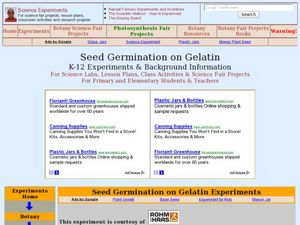Curated OER
Classifying Monocot And Dicot Plants
Sixth graders identify the parts of a flower, and tell the difference between monocots and dicots. They group plant by leaf types and characteristics placing the information in table form on the computer.
Curated OER
How Do Flowering Plants Reproduce
Students investigate how flowering plants reproduce. They identify and describe the functions of the major sexual organs of a flower and fruit by examining and dissecting flowers and fruit.
Curated OER
Monocots vs. Dicots
Learners examine the differences in nonvascular and vascular plants. They compare the differences between gymnosperm and angiosperms. Students compare the differences between moocots and dicots. They view a powerpoint presentation on...
Curated OER
Structure of Seeds and Effects of Fertilizer on Plant Growth
Investigate the structure of seeds and the effects of fertilizer on the growth of plants. Young scientists observe a peanut and determine if it is a monocot or dicot plant. They plant seeds and make varying solutions of fertilizer, then...
Curated OER
Culturing Plants from Embryonic Plant Tissue
Student groups use lima beans to represent dicots and corn to represent monocots, soak the seeds, and separate the embryos from the cotyledons. They then place the seeds in Petri dishes in agar and observe for at least one week recording...
Curated OER
Investigation Xylem
Students investigate how water travels up the stem of vascular plants by using food coloring to stain the xylem of a number of different plants. They know the function of leaves, stems, and root at the end of the experiment.
Curated OER
Germination: Name that Seed
Young scholars investigate seeds, flowers and germinating seeds. In this germination lesson plan, students observe a stalk of corn, a corn seed, Gladiolas and glass jars containing germinating sees and plants. Young scholars answer 8...
Curated OER
Investigating Monocots and Dicots
Pupils know about monocotyledons and dicotyledons. They explore the differences between the seed structure of the two by examining bean and corn seeds. They sprout seed to observe the differences in both of their growths.
Curated OER
The Effects of Environment on Plant Growth: Selecting Seeds for Survival on a New Planet
Fifth graders conduct experiments to compare seed germination and plant growth rates. They construct a hydroponic plant unit and a lighthouse. They care for the plants for a month and collect data for graphs. They write a report.
Curated OER
A Botanists View
Young scholars explore plant and seed structure. They dissect a seed and identify its parts. In addition, they explain the function and compare and contrast monocotyledon and dicotlyledons.
Curated OER
Seed Germination on Gelatin
Students examine how seeds germinate in a culture. In this germination lesson students germinate seeds in gelatin and observe the growth of the plant.
Curated OER
Look at Those Seeds Grow!
Students explore plant science by participating in a botany activity. In this seed growth lesson, students identify the necessary elements to ensure a plant grows well and prepare seeds for planting. Students plant their soaked seeds in...
Curated OER
Sunlight Necklaces
Third graders review the placement and role of the sun in the solar system. Using beads, they create a necklace which they can use to identify the amount of sunlight is being illuminated. In groups, they record observations on the...
Curated OER
Prairie Find Outdoors
Students take a field trip to a local prairie. Using identification books, they identify various forbs and grasses in the prairie. As a class, they discuss the importance of forbs and grasses to the ecosystem and review the various types...
Curated OER
Germinating Seeds on Gelatin
Students germinate seeds in unflavored gelatin to which liquid house plant food has been added. Students observe and record plant growth in this medium with a variety of variables in a number of experiments.
Curated OER
Seed Dispersion of Strawberries and Dandelions
Students investigate how seeds are dispersed on land. In this plant biology lesson, students use a dissecting microscope to study strawberry seeds and dandelion seeds, they draw what they see, then create a hypothesis on the seeds...
Curated OER
Time Lapse Seed Germination with the QX3 Intel Digital Microscope
Learners use the time-lapse feature of the QX3 Intel Digital Microscope
to observe germination of seeds. They use the QX3 Intel Digital microscope to create time lapse video films of seed germination experiments.


















